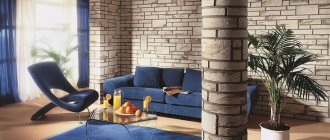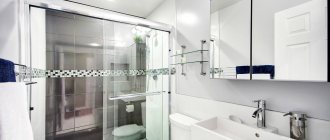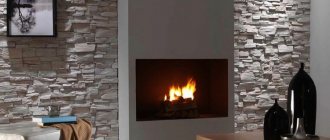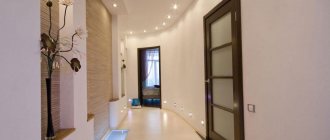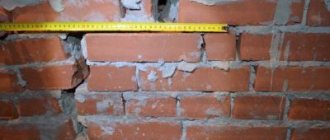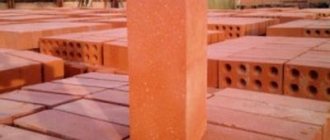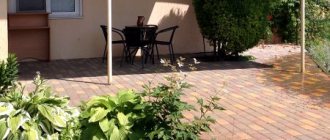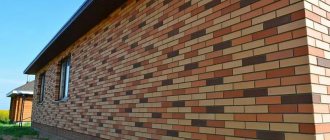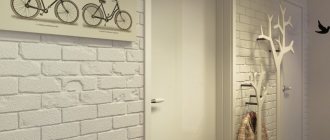People living in city apartments dream of cozy balconies and loggias. The balcony space is very tiny, but it can be stylish - interesting design effects can be realized on the balcony. Now there are a lot of options available that allow you to create a beautiful brick balcony design. The simplest and most effective way to finish brickwork on a loggia is traditional painting. Naturally, it makes sense to carry out any finishing work if the balcony is glazed, and better if it is insulated.
Material selection
Construction stores offer a huge range of materials that look like brickwork. Using real brick is problematic. This is due to the fact that it has a lot of weight, which creates an increased load on the floors and takes up some of the free space. Therefore, if you want to complement the design with brickwork, it is recommended to pay attention to materials that imitate it:
- Wallpaper. Their use is the easiest way to imitate masonry. There are options on sale that are practically indistinguishable from natural material. Wallpapering has many advantages. First of all, it is easy to install. To glue them you will need a minimum of skills and tools. In addition, there are options that differ in shade, texture and size of bricks. You will also be pleased with the cost of brick wallpaper.
Wallpaper imitating decorative brick Source roomester.ru
- Plastic panels. Modern technologies have made it possible to decorate even plastic to look like brick. By choosing a quality product, you can create a design that will look no different from using real brickwork. Among the advantages of this material is its lightness. This will be especially relevant for those whose balcony cannot boast of a strong ceiling. The panels are favored by their lightness and long service life. They are able to maintain their aesthetic properties for a long period of time. Plastic is resistant to high humidity and rust formation, and withstands temperature fluctuations well. It is easy to care for, create compositions with its help, and if necessary, you can easily replace part of the structure. In addition, plastic has an affordable price.
- Veneers. This option is more expensive, but also looks more aesthetically pleasing. Veneers are bricks made using natural materials (wood, clay, glass, leather). They are suitable not only for decorating an entire balcony, but also for creating spot compositions. Veneers are much lighter than brick and are practically not exposed to external climatic factors. It's very easy to install them.
Imitation of brickwork Source stroy-podskazka.ru
- Tile. This is the most common way to decorate a balcony with natural brick. The tile is easy to lay, it is strong, durable and has an attractive appearance.
Large area balcony design Source stroy-podskazka.ru
Decorative stones in the interior
This cladding is a tile, the surface and finish of which resembles natural stone. After cladding, the appearance of brick or stone masonry is created on the walls of the loggia.
Decorative stone for balcony cladding
Prices for this type of material are determined by its certain qualities and appearance.
Structure of decorative stone
This stone is made from cement. At the same time, different types of this building material are used: white cement, which is produced abroad, and gray, domestic. The cost of decorative tiles based on white cement is slightly higher. Other ingredients for such cladding: sand, expanded clay or perlite. The weight of the resulting tile depends on their properties. Products with expanded clay are lighter, but also less wear-resistant. Sand allows you to produce tiles of higher quality.
An equally important component of decorative stone is pigment or paint. It affects how the finished material will look. Prices for dyes vary. With less expensive tiles, the tiles will be of poor quality; the paint on its surface will fade over time. To avoid making a mistake, when purchasing a decorative stone, you need to examine and even touch its front side - it should not have any roughness or depressions.
How to paint a brick wall on a balcony
Natural brickwork looks very impressive, but there are situations when the wall requires painting. For example, it is necessary for:
- Wall protection. This is relevant if changes in temperature and humidity are possible on the balcony. The paint will protect against the penetration of water drops that can destroy the material.
- Aesthetic design. Brick may not fit into the style of the room. But if you paint it, the wall can sparkle with new notes and become the highlight of the interior.
Before painting decorative bricks, the surface must be prepared for work. There are paints that can hide small cracks and even out minor unevenness. Latex-based material has these properties. What does the preparation consist of:
- the wall is cleaned of the old coating, all remnants of mortar and plaster are removed;
- the wall is treated with special solutions that have antifungal properties and prevent the appearance of mold on the surface;
- the surface is cleaned of dust and dirt using a compressor or vacuum cleaner;
- a primer with a special composition is applied, which makes it possible to increase the moisture resistance of the coating, improve its characteristics and waterproofing properties;
- defects and seams are sealed with compounds that are suitable for outdoor work;
- The wall is re-primed.
A room decorated in brown and beige tones Source lesoprodukt12.ru
In some cases, plastering of the surface using universal compounds with moisture-repellent properties is also required. Despite the fact that they are somewhat more expensive than conventional ones, their use will make the coating resistant to various negative influences.
Using Roman blinds in the interior Source stroy-podskazka.ru
After the wall has been pre-treated, you can start painting it.
An example of laying a brick parapet on a loggia with subsequent glazing
In this review, we will look at an example of the construction of a new brick parapet on a loggia.
To begin with, let's get acquainted with the initial appearance of the object of the upcoming work - it is a straight loggia with a fence made of a metal frame and asbestos-cement slabs, covered with iron sheets. The old glazing of the loggia is made of wooden frames. As we can see, from the outside the loggia looks completely unattractive. Wooden glazing frames require painting, which will need to be repeated periodically. The tightness of the structure is extremely low, so it is simply not advisable to insulate such a loggia. The owners decided to install a new parapet and warm plastic glazing.
Let's start dismantling.
We clean the floor surface from construction debris.
The base of the loggia is a reinforced concrete slab. It has high strength and can bear a large load. We are starting to build a new parapet made of white sand-lime brick on it.
To eliminate lateral vibrations and loosening of the fence, we connect it to the side walls using metal reinforcement rods.
To increase the strength of the parapet structure, every three rows of brickwork we place a metal mesh in the mortar layer.
External view of the built parapet
We install warm glazing from PVC swing windows. We connect window structures to each other using connecting strips. To avoid the formation of cold bridges, fill the space between the connecting strip and the window frame with polyurethane foam.
View of the installed glazing from the inside.
Painting methods
There are several ways to paint a brick wall:
- Painting with a brush. You can paint the entire wall with one chosen color or use different shades for the bricks and seams. The second option will add additional volume to the interior and the more contrasting the shades, the more impressive it will look. Painting is carried out in sectors from the top of the wall to the bottom.
Unusual use of a balcony room Source design-homes.ru
- Painting with a roller. When processing a flat surface, it is recommended to use narrow rollers. First, the seams are painted with a brush, after which several layers of paint are applied to the wall with a roller.
White and purple design in Scandinavian style Source rem-balcon.ru/
- Stencil technology. When painting a wall, you can use additional decoration. The outlines of a suitable design are printed. The resulting stencil is used to apply a design to the wall. To ensure an even image, you need to use a small roller.
Industrial style in the interior Source mainavi.ru
- One brick technique. This technique involves painting bricks in different shades. It looks very original, but is not suitable for everyone. Colors can be placed in a ladder, in the form of a chessboard, or randomly. Unlike previous methods, here the wall is painted first, and only then the seams are processed.
Multi-colored decorative brick Source stroyfora.ru
- Writings on the wall. You can effectively transform your balcony if you make an inscription on top of the painted bricks. Catchphrases, aphorisms, and famous quotes will do. To ensure a high-quality image, the letters are first applied with a simple pencil, so that if necessary, you can change or adjust what is written. In addition, you can use a ready-made stencil.
Arranging a place to relax Source design-homes.ru
Finishing features
Today there is hardly a person indifferent to the decoration of premises with their accentuation by brick texture. For several seasons in a row, brickwork has been considered one of the best types of material. With its help you can add a special atmosphere and high status to the interior of any room. It’s good when the loggia or balcony is made of brick: it’s enough to refine them.
However, in a panel house, laying brick is not always possible, which is why it is necessary to select materials that imitate the desired texture. Excess weight for a balcony slab or loggia is undesirable, because to create a cozy island you will have to perform a number of works on exterior finishing, cladding, glazing and insulation. You also need to install furniture.
Not all balconies can withstand such a load.
This is especially problematic for the balconies of Khrushchev-era buildings, which today are not in the best condition. Therefore, after reconstruction here, as in panel houses, it is necessary to use decorative bricks. Without being inferior in external indicators, it saves the situation and allows you to equip the interior of a small space for a room for various purposes.
Paint selection
There is a large selection of paints suitable for painting decorative bricks on the balcony. Each of them has its own characteristics:
- Water-based is the cheapest and most accessible option. It consists of a mixture of pigments that are dissolved in water. The advantage of this paint is good permeability and environmental friendliness. It doesn't have a strong smell and dries quickly. The only drawback of water-dispersion paint is the high consumption of material.
- Latex. Acrylic copolymer is used for its production. Most often it is used for painting wallpaper. It is durable, washes well, has high elasticity and is resistant to direct sunlight. There is no unpleasant odor in the room after using it. The disadvantage is low permeability.
- Acrylic. Created on the basis of polyacrylates with the addition of film formers. The paint is elastic, moisture-resistant and has a wide palette of shades. Among its disadvantages is that it dries too quickly, so after opening the can, the paint must be used within several hours, otherwise it will dry out completely.
- Silicone. It is characterized by increased plasticity and permeability. It is environmentally friendly and may contain antibacterial components. Another advantage of silicone paint is its high level of adhesion. The cost of this material is quite high, but if you take into account the long period of operation, the cost of its purchase can be considered justified.
- Alkyd. The paint dries very quickly. This must be taken into account when carrying out repair work. Another drawback is a strong unpleasant odor that will take a long time to dissipate.
Surface preparation
An important process when painting is preliminary preparation. It may consist only of priming, or may additionally include other technological operations. The first step is to decide what effect you want to achieve. If the goal is to update the color, for example, repainting it from white to black, then you should first make sure that the old paint adheres well. If it is not there, then using a sharp spatula and a metal brush you need to remove the old coating, prime the cleaned surface, and then apply a layer of new paint.
If the wall is being painted for the first time, it needs to be washed and then make sure there are no major defects, especially for seams. If cracking occurs, the seams must be repaired. For this, a cement-sand mortar is used. Its complete drying time is about a week. After eliminating the defects, the wall is primed; if necessary, this should be done in two layers.
Plaster will help radically change the coating . With its help, the wall will turn from brick into smooth. After this, no one will be able to guess what the partition is made of. As a solution, you can use a cement-sand mixture or gypsum. The second is characterized by rapid hardening, but is afraid of moisture. It is best used on glazed balconies or loggias.
Plaster application is carried out in two stages. The first consists of leveling the wall. To do this, metal beacons of the required thickness are attached to the surface. Place them a meter apart and level them. To fix them, use a gypsum mixture or dowels with self-tapping screws. The space between them is filled with ready-made mortar and, using the rule, the wall is smoothed. After drying, it is advisable to remove the beacons, but you can leave them in the wall, simply by putting putty on top.
At the final stage, a finishing solution is applied to the surface to make it smooth. After complete drying (at least 24 hours must pass), the plaster is cleaned of defects using sandpaper and a primer is applied. Once it is dry, you can proceed to painting the wall.
How to decorate a brick wall on a balcony
You can decorate a wall with brick in different ways:
- Full wall finishing. This method is suitable for every balcony. If it is closed, the cladding is carried out on all sides, and if it is open, then it is laid only on the wall that is adjacent to the room. When choosing a shade, you need to proceed from the size of the room. If you use dark colors on a small balcony, it will look gloomy, boring and smaller than it actually is. But light neutral tones can expand the space.
- Arch cladding. For those balconies that are connected to the living room using an arch, brick finishing of its perimeter will be an ideal design option. To make a harmonious transition between rooms, the slopes of the arch are laid out with the same material as the walls on the balcony.
Decorating the arch with decorative bricks Source uk.aviarydecor.com
- Highlighting corners and slopes. This method will make the design complete. This option can be combined with finishing the wall adjacent to the room with the same material. The corners of the balcony lined with decorative bricks will look harmonious.
- Partial finishing. Partial application of bricks on walls, corners, and slopes in a chaotic manner looks cozy and relaxed. Despite the asymmetry, it will look harmonious. And the combination of decorative bricks with other finishing materials will save on repairs.
Decorating a small balcony Source design-homes.ru
Originality of rough masonry
Having seen a photo of a brick balcony on the Internet, it is difficult to resist the desire to make something similar into reality, to experiment, to show imagination about your balcony. I want to create coziness and comfort throughout the entire apartment without exception.
In a small area, you can also skillfully apply various design solutions. A skillfully designed brick wall on the balcony will make this corner of the apartment original.
Artificial aging of brick
Old masonry is characterized by chips, cracks and the absence of some bricks.
Note!
- Window sill on the balcony - functions and advantages of a window sill on the balcony. Types of window sills. Choice of material. Methods of fastening and installation (photo + video)
Decorating a balcony with stone: 145 photos and video description of how to decorate a balcony in a stylish and beautiful way
Living room with a balcony - 115 photos of the best ideas and beautiful combinations of a balcony with a room
For artificial aging, each brick must be treated. They chip randomly. Sandpaper wipes all the bricks.
If desired, the seams are rubbed with moss or earth. To fix the result, cover the wall with a couple of layers of acrylic varnish.
You need to know that.
- If you find mold on bricks, such a base cannot be painted without preliminary cleaning. The affected area should be thoroughly washed and treated with an antiseptic. It would be even safer to choose a paint that contains antibacterial additives.
- Before applying paint, the walls should be properly primed. This is done in order to increase adhesion. Experts always recommend buying a primer and a coloring composition of the same brand (manufacturer).
- Remember that the paint is applied to a completely dry surface. That is why you should wait at least 6 hours from the moment of applying the primer.
Required coating thickness
When painting, you need to remember a few important rules that will help you get the job done quickly and efficiently:
- pay attention to the paint markings and surface texture to determine whether it is necessary to apply a second layer, because when applying a large amount of paint, it will not dry well, and may subsequently swell and peel off;
- to carry out the painting process carefully, you should stick masking tape between the ceiling and walls so that the border between the surfaces is smooth;
- for paint, you should purchase a special container, with which you can remove excess paint from the roller and evenly apply the composition to the walls;
- paint in one direction, avoiding unsightly lines and drips;
- When using a sprayer, monitor the intensity of spraying; it should be uniform. To learn how to paint brickwork, watch this video:
By applying all the tips and choosing the right paint, you can easily update the brickwork on your balcony. The room will become unusual if you apply different design solutions.
Frame sheathing
Brick itself is an excellent decorative material, on the basis of which you can create interesting effects on the balcony. But not everyone likes him. In this case, you can use cladding. For this purpose, facade plasters, plastic or siding panels are used.
Interior decoration based on plastic is already a classic solution. It is perfect for those who do not care about design, but what matters is practicality. Plastic is very practical. The material is not afraid of moisture, ultraviolet radiation, or temperature changes.
As for the design of the room, the desired atmosphere is created by panels of different colors and various decorative elements. Plastic can also be combined with any other materials.
Lovers of natural materials can use lining instead of plastic - it is quite aesthetically pleasing and cozy. You can use lining (about clapboard cladding in the article: “Creating a stylish balcony design from lining: wall decoration and design options”) or natural wood panels to cover the surface of the walls, ceiling and floor. And to dilute the design, you need to use various elements that will attract attention.
If you approach the finishing of brick balconies competently and take into account all the tips, the painted surface will not disappoint, but will give the room a modern and cozy appearance.
Changing the look of the loggia
Today we will talk about a completely different type of finishing of loggias and balconies, rather than plastic or lining, and it will be decorative brick-like tiles. Some readers already know that I have two loggias. I wrote about one of them. Several articles were devoted to the topic of combining a loggia with a room and its insulation
Namely, insulation with polystyrene foam, three articles were devoted to this important topic. All of them can be found on the website
And also, there is an interesting article dedicated to choosing a heated floor. I invite you to get acquainted with them.
And now the next step is the interior decoration of the loggia with decorative tiles. Looking ahead a little, I will say that my loggia will be decorated with two types of tiles: brick-like and stone-like, much like here. In the photo you can see the tile finish, just like brick.
So. After the loggia was carefully insulated, for further interior decoration, namely the left and right walls, as well as the parapet, I decided to use decorative gypsum cement tiles - “Casavaga”. I was very pleased with the wide range and low price compared to other analogues.
Decorative tiles are sold in boxes - one box (1 m2). Let's say it comes with a special glue that comes with it. When it dries it becomes white, in the photographs below taken as an example, this is clearly visible. If desired, you can use regular tile adhesive. By the way, the decorative tiles in the photo below are “300 series”.
THE PRICE FOR LAYING DECORATIVE TILES CAN BE FOUND ON THIS PAGE
